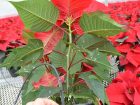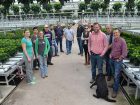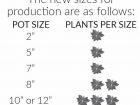
News
A Great Finish To Near-Perfect Poinsettia Season
We need stock producers to adopt more biological control so that growers can build on a good thing rather than trying to reverse any effects of chemical residues.
January 14, 2016 By Melhem Sawaya
 ‘Christmas Beauty’ is great for solid trees.
‘Christmas Beauty’ is great for solid trees. Sales started slow this past poinsettia season compared to other years, but they finished strong. The weather was great for sales and shipping, with no snow, frozen loads or blizzards to keep shoppers away.
The slow start was only for those outlets that raced to put poinsettias on their shelves before Remembrance Day, thinking that the red poinsettia is the same as red poppy.
Poinsettias are for Christmas and any push to try to sell them early is a recipe for sales shrinkage. Early products that don’t move start to look bad. That means that when consumers are ready to buy, all they find are dead poinsettias, or at best plants that are far from fresh.
“Timing is everything,” and no, we do not need snow to sell poinsettias. About 70 per cent of the poinsettias grown are sold in regions that never get snow.
About 95 per cent of the poinsettia crop grown in Ontario was sold within the province. The low dollar helped to move a very low percentage (less than two per cent) south, and this was due to the fact that growers and buyers establish their programs six to12 months in advance; last minute or spot buying is almost non-existent.
Buyers for large chains have to have consistent suppliers for more than one product. That is why spot buying is their last choice. A buyer managing 100 or more stores does not want to deal with too many suppliers. This is a positive, because long-term programs will prevent price-cutting. Not only that but the grower and buyer will know what they are getting into right at the start of growing the crop.
THE IMPACT OF RISING SHIPPING COSTS
Long overdue by growers is the realization of how fast shipping costs are rising, which are up by 30 per cent over the last few years even with relatively low fuel costs. This has triggered more co-operation among growers to grow product for stores closer to their area. As well, buyers are working to find suppliers as close to their stores as possible. Calculating costs must include every aspect of growing and selling the crop.
The demand for large pot sizes and plants has been lower than normal.
Different varieties and production schedules are needed for different sizes. Following these sizes is a good thing, because that’s when the plants are used to their maximum potential at the most economical cost. What is more important is that it will help consumers enjoy the plants for a much longer period of time.
Production: Most stock producers are doing a better job every year, with good quality cuttings that are fairly pest-free. All we need now is for the stock producers to adopt more biological control in fighting pests so that growers can build on a good thing – rather than trying to reverse any effects of chemical residues – to have a more effective biological control program of their own.
The whitefly battle still rages, whether using biologicals or chemicals. The most effective control seems to be a combination of biologicals at the beginning and finishing with chemicals. However, if the goal is for chemical-free greenhouses, then the biological producers will have to come up with beneficial predators that can clean-up the last of the whiteflies. We used to rely on Eretmocerus mundus, the predator that can do the job, but they stopped producing it because it is not allowed in the U.S. and is difficult to produce. The good news is that I know of one biological company that is going to produce it, but its availability is going to be to those growers who are going to use their total biological program for the other pests.
The past season was the best year ever for rooting poinsettias. The cuttings arrived on time and were of good quality. With last year’s great moderate summer temperatures, growers were able to root poinsettias in record time, ensuring a good start for a touchy crop. In addition to all of this, the excellent fall weather helped in having the best poinsettia crop ever. The crop ended up being:
- Earlier than normal due to the higher solar energy.
- Larger than normal.
- Grown with reduced heat costs.
- Produced with very little shrinkage, if any.
- Grown with negligible disease pressure.
There was very little bract edge burn and no botrytis. And if the plants were ordered for a reasonable sales date, there was very little shrinkage in the stores.
Varieties: Few new varieties are going to be in production this year, but that’s not the case for 2017 when many varieties will be introduced. As we’ve often said here, try the new varieties and then decide if you want to include them in your program. And if you do add them, remember to drop your least desirable variety.
The 2015 poinsettia trials were moved from the Vineland Research and Innovation Centre to nearby Linwell Gardens. The result was improved flexibility and growing conditions. The trials are still under the supervision and coordination of Wayne Brown (retired OMAFRA greenhouse floriculture specialist) with the help of Linwell growers and staff.
A few varieties that look promising were displayed – some are new and others were introduced two to four years ago but are not yet widely grown. Varieties that are good for 5” pots are not necessarily good for 10” pots, or at least you need to modify the production schedule drastically to use the same variety for every size. Read the variety specs and try it in the new sizes.
Regardless of which variety you grow, it is important that when filling pots that the media is not flush with the pot rim.
Next season, the trials will include shelf life longevity, treatments of different growth regulators, and different production applications. The open house will be held as close to Nov. 20 as possible, at which time growers can view the varieties before they are mature, and before too many of them start to look the same.
This past season, a study group of growers and educators met once a month starting in June to discuss production issues. The sessions were mainly concentrated on whitefly control. The study group met in different greenhouse operations and the informal sessions included a discussion and tour.
REVIEWING PROBLEMS WITH THE 2015 CROP
Insects: Whitefly is the major pest in poinsettia but with the greater use of targeted biological control, other insects are popping up, such as Echinothrips and spider mites. And for the first time we have seen mealybugs that came with the cuttings of a couple of cultivars.
Diseases: Diseases were no issue last year due to the great weather and great cultivars. By paying attention to cultural practices, there were no problems at all even without the use of any fungicides – biological or chemical.
Physiological disorders: I saw some heat delay in a couple spots because of a malfunctioning heat valve. At another location, one light bulb over a sidewalk kept a 50-foot circle of plants green, but they recovered in time to be shipped just before Christmas.
IN SUMMARY
- Grow varieties you are most familiar with, and try new ones on a small scale.
- Calculate your cost for any required specs and do not forget about packaging and shipping.
- Take an order when there is still some margin profit and not just dollar sales.
- Never grow on pure speculation.
- Running out of plants at the end of the season and having to buy some is a sign you are starting to make headway on improved profitability!
- Do not cheat on what the crop needs to grow properly; it will cost you much more at the end if you do.
- Start a study group with the growers in your vicinity. Send me a note if you want ideas on how to set one up.
- And last, but not least, if all the factors that took place this year are repeated next year, then growing poinsettia could indeed be profitable.
Melhem Sawaya is a consultant and research coordinator to the horticultural industry. mel@focusgreenhousemanagement.com
Print this page





